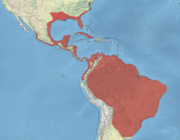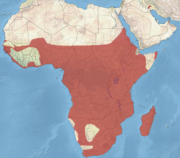Darter
| Darter | |
|---|---|

| |
| Male African darter Anhinga rufa | |
| Scientific classification | |
| Domain: | Eukaryota |
| Kingdom: | Animalia |
| Phylum: | Chordata |
| Class: | Aves |
| Order: | Suliformes |
| Family: | Anhingidae Reichenbach, 1849[1] |
| Genus: | Anhinga Brisson, 1760 |
| Type species | |
Plotus anhinga
, 1766 | |
| Species | |
|
| |

| |
| World distribution of the family Anhingidae | |
| Synonyms | |
|
Family-level: Genus-level: | |
The darters, anhingas, or snakebirds are mainly
Description


Anhingidae are large birds with
There is no
Darter vocalizations include a clicking or rattling when flying or perching. In the nesting colonies, adults communicate with croaks, grunts or rattles. During breeding, adults sometimes give a caw or sighing or hissing calls.
Distribution and ecology

Darters are mostly
Diet
Darters feed mainly on mid-sized
Predation
Breeding
They usually breed in colonies, occasionally mixed with cormorants or herons. The darters pair bond monogamously at least for a breeding season. There are many different types of displays used for mating. Males display to attract females by raising (but not stretching) their wings to wave them in an alternating fashion, bowing and snapping the bill, or giving twigs to potential mates. To strengthen the pair bond, partners rub their bills or wave, point upwards or bow their necks in unison. When one partner comes to relieve the other at the nest, males and females use the same display the male employs during courtship; during changeovers, the birds may also "yawn" at each other.[10]

Breeding is seasonal (peaking in March/April) at the northern end of their range; elsewhere they can be found breeding all year round. The
These birds reach sexual maturity by about two years, and generally live to around nine years. The maximum possible lifespan of darters seems to be about sixteen years.[12]
Darter eggs are edible and considered delicious by some; they are locally collected by humans as food. The adults are also eaten occasionally, as they are rather meaty birds (comparable to a
Systematics and evolution
The
This family is very closely related to the other
The Sulae are also united by their characteristic
The Sulae were traditionally included in the
Living species
There are four living species of darters recognized, all in the
| Common name | Scientific name and subspecies | Range | Size and ecology | IUCN status and estimated population |
|---|---|---|---|---|
| Anhinga or American darter | Anhinga anhinga (Linnaeus, 1766) Two subspecies
|
southern United States, Mexico, Cuba, and Grenada, Brazil.
|
Size: Habitat: Diet: |
LC
|
| Oriental darter | Anhinga melanogaster Pennant, 1769 |
tropical South Asia and Southeast Asia.
|
Size: Habitat: Diet: |
NT
|
| African darter | Anhinga rufa (Daudin, 1802) Two subspecies
|
sub-Saharan Africa and Iraq.
|
Size: Habitat: Diet: |
LC
|
| Australasian darter | Anhinga novaehollandiae Gould, 1847 |
Australia, Indonesia, and Papua New Guinea
|
Size: Habitat: Diet: |
LC
|
Extinct "darters" from
Fossil record

The
Fossil Anhingidae are known since the
- Meganhinga Alvarenga, 1995 (Early Miocene of Chile)
- "Paranavis" (Middle/Late Miocene of Paraná, Argentina) – a nomen nudum[25]
- Macranhinga Noriega, 1992 (Middle/Late Miocene – Late Miocene/Early Pliocene of SC South America) – may include "Anhinga" fraileyi
- Giganhinga Rinderknecht & Noriega, 2002 (Late Pliocene/Early Pleistocene of Uruguay)
- Anhinga
Prehistoric members of Anhinga were presumably distributed in similar
- Anhinga walterbolesi Worthy, 2012 (Late Oligocene to Early Miocene of central Australia
- Anhinga subvolans (Brodkorb, 1956) (Early Miocene of Thomas Farm, US) – formerly in Phalacrocorax[27]
- Anhinga cf. grandis (Middle Miocene of Colombia –? Late Pliocene of SC South America)[28]
- Anhinga sp. (Sajóvölgyi Middle Miocene of Mátraszõlõs, Hungary) – A. pannonica?[29]
- "Anhinga" fraileyi Campbell, 1996 (Late Miocene –? Early Pliocene of SC South America) – may belong in Macranhinga[30]
- Anhinga pannonica Lambrecht, 1916 (Late Miocene of C Europe ?and Tunisia, East Africa, Pakistan and Thailand –? Sahabi Early Pliocene of Libya)[31]
- Anhinga minuta Alvarenga & Guilherme, 2003 (Solimões Late Miocene/Early Pliocene of SC South America)[32]
- Anhinga grandis Martin & Mengel, 1975 (Late Miocene –? Late Pliocene of US)[33]
- Anhinga malagurala Mackness, 1995 (Allingham Early Pliocene of Charters Towers, Australia)[34]
- Anhinga sp. (Early Pliocene of Bone Valley, US) – A. beckeri?[35]
- Anhinga hadarensis Brodkorb & Mourer-Chauviré, 1982 (Late Pliocene/Early Pleistocene of E Africa)[36]
- Anhinga beckeri Emslie, 1998 (Early – Late Pleistocene of SE US)[35]
Citations
- ^ Walter J. Bock (1994): History and Nomenclature of Avian Family-Group Names. Bulletin of the American Museum of Natural History, number 222; with application of article 36 of ICZN.
- ^ a b Answers.com [2009], BLI (2009), Myers et al. [2009]
- ^ Brodkorb & Mourer-Chauviré (1982), Myers et al. [2009]
- ^ a b c d Myers et al. [2009]
- Plotosidae (eeltail catfishes) and Poeciliidae(livebearers): Myers et al. [2009]
- Anura (frogs and toads), Caudata (newts and salamanders), snakes, turtles and even baby crocodilians: Myers et al. [2009]
- mollusks: Myers et al. [2009]
- doi:10.1111/j.2007.0908-8857.04070.x (inactive 2024-02-14).)
{{cite journal}}: CS1 maint: DOI inactive as of February 2024 (link - S2CID 86476224.
- ^ a b Kennedy et al. (1996), Myers et al. [2009]
- ^ Answers.com [2009], Myers et al. [2009]
- ^ AnAge [2009], Myers et al. [2009]
- ^ Brisson, Mathurin Jacques (1760). Ornithologie, ou, Méthode Contenant la Division des Oiseaux en Ordres, Sections, Genres, Especes & leurs Variétés (in French and Latin). Paris: Jean-Baptiste Bauche. Vol. 1, p. 60, Vol. 6, p. 476.
- ^ Mayr, Ernst; Cottrell, G. William, eds. (1979). Check-list of Birds of the World. Vol. 1 (2nd ed.). Cambridge, Massachusetts: Museum of Comparative Zoology. p. 170.
- ^ Jobling (1991): p.48, MW [2009]
- ^ E.g. genera like Borvocarbo, Limicorallus or Piscator: Mayr (2009): pp.65–67
- ^ Brodkorb & Mourer-Chauviré (1982), Olson (1985): p.207, Becker (1986), Christidis & Boles (2008): p.100, Mayr (2009): pp.67–70, Myers et al. [2009]
- ^ Kennedy et al. (1996)
- ^ Christidis & Boles (2008): p.100, Answers.com [2009], Mayr (2009): pp.67–70, Myers et al. [2009]
- ^ Gill, Frank; Donsker, David, eds. (2019). "Hamerkop, Shoebill, pelicans, boobies, cormorants". World Bird List Version 9.1. International Ornithologists' Union. Retrieved 2 April 2019.
- ^ Olson (1985): p.207, Becker (1986)
- ^ Miller (1966), Olson (1975), Brodkorb & Mourer-Chauviré (1982), Olson (1985): p.206, Mackness (1995)
- ^ Becker (1986), Mayr (2009): pp.67–70
- ^ Cione et al. (2000), Alvarenga & Guilherme (2003)
- ^ Named in a thesis and hence not validly according to ICZN rules. An apparently flightless species the size of A. anhinga: Noriega (1994), Cione et al. (2000)
- ^ Olson (1985): p.206
- plesiomorphic: Brodkorb (1956), Becker (1986)
- Acre, Brazil). Size identical to A. grandis, but distinctness in space and time makes assignment to that species questionable: Mackness (1995), Alvarenga & Guilherme (2003)
- phalanx: Gál et al. (1998–99), Mlíkovský (2002): p.74
- cervical vertebrae (LACM 135357-135358), three humerus pieces (LACM 135360, 135362-135363), probably also the almost complete left humerus UFAC-4562. A rather short-winged species about two-thirds larger than A. anhinga; apparently distinct from the living genus: Campbell (1992), Alvarenga & Guilherme (2003)
- cervical vertebra (the holotype) and a carpometacarpus; additional material includes another cervical vertebra and femur, humerus, tarsometatarsus and tibiotarsuspieces. About as large as A. rufa, apparently ancestral to the Old World lineages: Martin & Mengel (1975), Brodkorb & Mourer-Chauviré (1982), Olson (1985): p.206, Becker (1986), Mackness (1995), Mlíkovský (2002): p.73
- ^ UFAC-4720 (holotype, an almost complete left tibiotarsus) and UFAC-4719 (almost complete left humerus). The smallest known darter (30% smaller than A. anhinga), probably not very closely related to any living species: Alvarenga & Guilherme (2003)
- 25739 (another humerus piece). Longer-winged, about 25% larger than and twice as heavy as A. anhinga, but apparently a close relative: Martin & Mengel (1975), Olson (1985): p.206, Becker (1986), Campbell (1992)
- ^ QM F25776 (holotype, right carpometacarpus) and QM FF2365 (right proximal femur piece). Slightly smaller than A. melanogaster and apparently quite distinct: Becker (1986), Mackness (1995)
- ^ a b Ulna fossils larger than A. anhinga: Becker (1986)
- ^ The holotype is a well-preserved left femur (AL 288-52). Additional material consists of a proximal left femur (AL 305-2), a distal left tibiotarsus (L 193-78), a proximal (AL 225-3) and a distal (11 234) left ulna, a proximal left carpometacarpus (W 731), and well-preserved (10 736) and fragmentary (2870) right coracoids. Slightly smaller than A. rufa and probably its direct ancestor: Brodkorb & Mourer-Chauviré (1982), Olson (1985): p.206
- ^ Olson (1985): p.206, Mackness (1995), Mayr (2009): pp.62–63
General and cited sources
- Alvarenga, Herculano M.F.; Guilherme, Edson (2003). "The anhingas (Aves: Anhingidae) from the upper tertiary (Miocene-Pliocene) of southwestern Amazonia". S2CID 84072750.
- AnAge [2009]: Anhinga longevity data. Retrieved 2009-SEP-09.
- Answers.com [2009]: darter. In: Columbia Electronic Encyclopedia (6th ed.). Columbia University Press. Retrieved 2009-Sep-09.
- Becker, Jonathan J. (1986). "Reidentification of "Phalacrocorax" subvolans Brodkorb as the earliest record of Anhingidae" (PDF). JSTOR 4087190.
- Brodkorb, Pierce (1956). "Two New Birds from the Miocene of Florida" (PDF). S2CID 86895919.
- Brodkorb, Pierce; Mourer-Chauviré, Cécile (1982). "Fossil anhingas (Aves: Anhingidae) from Early Man sites of Hadar and Omo (Ethiopia) and Olduvai Gorge (Tanzania)". .
- BirdLife International (2016). "Anhinga melanogaster". . Retrieved 12 November 2021.
- Campbell, K.E. Jr. (1996). "A new species of giant anhinga (Aves: Pelecaniformes: Anhingidae) from the upper Miocene (Huayquerian) of Amazonian Peru". Natural History Museum of Los Angeles County Contributions in Science. 460: 1–9.
- ISBN 978-0-643-06511-6
- Cione, Alberto Luis; de las Mercedes Azpelicueta, María; Bond, Mariano; Carlini, Alfredo A.; Casciotta, Jorge R.; Cozzuol, Mario Alberto; de la Fuente, Marcelo; Gasparini, Zulma; Goin, Francisco J.; Noriega, Jorge; Scillatoyané, Gustavo J.; Soibelzon, Leopoldo; Tonni, Eduardo Pedro; Verzi, Diego & Guiomar Vucetich, María (2000): Miocene vertebrates from Entre Ríos province, eastern Argentina[permanent dead link]. [English with Spanish abstract] In: Aceñolaza, F.G. & Herbst, R. (eds.): El Neógeno de Argentina. INSUGEO Serie Correlación Geológica 14: 191–237.
- Gál, Erika; Hír, János; Kessler, Eugén; Kókay, József (1998–99). "Középsõ-miocén õsmaradványok, a Mátraszõlõs, Rákóczi-kápolna alatti útbevágásból. I. A Mátraszõlõs 1. lelõhely" [Middle Miocene fossils from the sections at the Rákóczi chapel at Mátraszőlős. Locality Mátraszõlõs I.] (PDF). Folia Historico Naturalia Musei Matraensis (in Hungarian and English). 23: 33–78. Archived from the original (PDF) on 2011-07-21. Retrieved 2007-02-06.
- Jobling, James A. (1991): A Dictionary of Scientific Bird Names. Oxford University Press, Oxford, UK. ISBN 0-19-854634-3
- Kennedy, Martyn; Spencer, Hamish G.; Gray, Russell D. (1996). "Hop, step and gape: do the social displays of the Pelecaniformes reflect phylogeny? Animal Behaviour". Animal Behaviour. 51 (2): 273–291. S2CID 235331320.
- Mackness, Brian (1995). "Anhinga malagurala, a New Pygmy Darter from the Early Pliocene Bluff Downs Local Fauna, North-eastern Queensland". .
- Martin, Larry; Mengel, R.G. (1975). "A new species of anhinga (Anhingidae) from the Upper Pliocene of Nebraska" (PDF). JSTOR 4084425.
- Mayr, Gerald (2009): Paleogene Fossil Birds. Springer-Verlag, Heidelberg & New York. ISBN 3-540-89627-9
- Merriam-Webster (MW) [2009]: Online English Dictionary – Anhinga. Retrieved 2009-Sep-09.
- Miller, Alden H. (1966). "An Evaluation of the Fossil Anhingas of Australia" (PDF). S2CID 87211599.
- Mlíkovský, Jirí (2002): Cenozoic Birds of the World (Part 1: Europe). Ninox Press, Prague.
- Myers, P.; Espinosa, R.; Parr, C.S.; Jones, T.; Hammond, G.S. & Dewey, T.A. [2009]: Animal Diversity Web – Anhingidae. Retrieved 2009-Sep-09.
- Noriega, Jorge Ignacio (1994): Las Aves del "Mesopotamiense" de la provincia de Entre Ríos, Argentina ["The birds of the 'Mesopotamian' of Entre Ríos Province, Argentina"]. Doctoral thesis, Universidad Nacional de La Plata [in Spanish]. PDF abstract
- Olson, Storrs L. (1975). "An Evaluation of the Supposed Anhinga of Mauritius" (PDF). JSTOR 4084567.
- Olson, Storrs L. (1985). "The Fossil Record of Birds" (PDF). Avian Biology. 8: 206–207 (Section X.G.5.c. Anhingidae). ISBN 9780122494086. Archived from the original(PDF) on 2011-07-18. Retrieved 2009-09-09.




